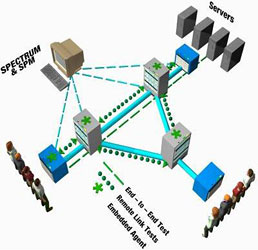|
|

By Jim
Lochran
As the mix of service
provider offerings become more IP centric,
the need to overhaul existing service
performance management techniques becomes
increasingly acute. Historically, performance
measurement of traditional fixed line
services was well understood and very
robust, this changed with the advent
of converged networks and IP based
services. In today’s environment,
service performance management is proving
to be an area of considerable challenge
both from a technology and cost perspective.
These challenges are compounded by
the fact that the infrastructure itself
is still evolving as more and more
services are being transformed into
application components that collectively
create a service. The paradigm shift
in the architecture coupled with the
ever growing demand for higher service
quality is driving Communication Service
Providers (CSP) to re-think their approach
to Service Performance Management.
Service Performance
Management is the process of measuring
and monitoring the time it takes for
services to respond to user requests
and aiding in the isolation of the
root cause of poor response time. A "service" is
the unit of work a user has requested,
whether directly or indirectly, via
the infrastructure. This could be a
complete transaction, such as submitting
an order via a web site (amazon.com),
downloading a file from an ftp server
(iTunes), or logging into the mail
server. A "Service" could
also refer to an underlying infrastructure
services, such as assignment of an
IP address from the DHCP server or
a request for name services resolution
from the DNS server. In many cases,
a service makes use of other services.
For example, to access a web site the
user enters a URL into their browser,
which issues a request for name resolution
(using the DNS server) and then attempts
to connect to the web server before
requesting the web page specified in
the URL. From the end users' perspectives,
the service is the web page, but in
actuality they have performed three
separate transactions using three unique
services (DNS, TCP, and HTTP).
Perhaps one of the
most challenging aspects of service
performance management is the data
- how to collect it, where to collect
it, how to process it, how to analyze
it and how to make use of it. There
are two primary approaches to collecting
service performance data, both involve
the use of probes; where one is embedded
within the routing infrastructure and
the other leverages a purpose built
appliance that is strategically placed
within the network. Often times these
two approaches will be used in concert
so that a complete performance picture
can be garnered. Combining the approaches,
however, does not resolve the need
to process and analyze the data. Since
the true measure of service performance
is determined
|
|
This article is sponsored by  . Integrated Solutions for Managing Converged Communication Services. . Integrated Solutions for Managing Converged Communication Services. |
|


by the cumulative
health of a collection of monitoring
points, the need exists for an
aggregation layer which can assemble
these monitoring points across
the infrastructure into a holistic
view of service performance.
It is from this holistic view
that the data can be analyzed
for base lining, trending, impact
and root cause analysis. Once
the data has been collected,
assimilated and analyzed the
question of how to make use of
the data can be addressed. The
uses of the data can be generically
considered in two ways; first
the data can be used in real-time
to proactively identify service
performance problems before subscribers
are impacted. Real time data
collection is extremely valuable
since its use can directly impact
the bottom line via increased
operational efficiencies and
decreased SLA violations. Secondly,
the data can be used for historical
reporting for capacity planning
and directed maintenance activities
within the infrastructure. The
value of the information collected
from the infrastructure is significant
as it can ensure business investments
are made at the right time and
operational efficiencies are
optimized.
When considering
the deployment of a service performance
management solution, CSP’s
should leverage a pragmatic approach
that emphasizes incremental improvements
instead of a wholesale replacement
of the current infrastructure.
The pragmatic approach can be
achieved by evaluating the current
capabilities within the infrastructure
in order to establish a foundation.
The foundation begins with basic
element performance. Metrics
such as Interface utilization,
errors / discards, CPU utilization,
etc. should be collected from
the network infrastructure via
the performance management system.
The collected information is
critical to service performance
issues as it is the basis for
root cause analysis.
article
page | 1 | 2 |
3 | |
|
|
 |
 |
|




